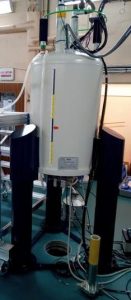LIQUID NMR
SOME RECENT PUBLICATIONS
Published abstracts
- An improved shielded RF coil for low-frequency NMR and MR, Kuzmin V., Nacher P.-J. , Bidinosti C.P., and Hayden M.E., Magn. Reson. Mater. Phy.. 26 Suppl. 1 (2013) 181-182.
- An active feedback scheme for low field NMR experiments, Baudin E., Safiullin K., Morgan S.W., and Nacher P.-J, J. Phys.: Conf. Ser. 294 (2011) 012009.
Regular article
An improved shielded RF transmit coil for low-frequency NMR and MRI
J. of Magn. Reson. 256 (2015) 70–76
V.V. Kuzmin, C.P. Bidinosti, M.E. Hayden, and P.-J. Nacher
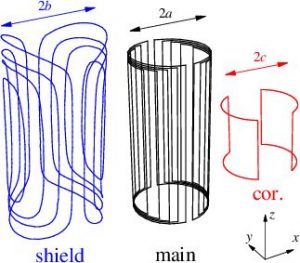
Regular article
Multiple echoes due to distant dipolar fields in NMR of hyperpolarized noble gas solutions
Morgan S.W., Baudin E., Huber G., Berthault P., Tastevin G., Goldman M., Nacher P.-J, and Desvaux H.
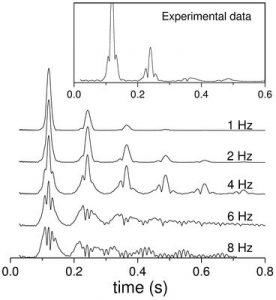
NMR IN HIGHLY MAGNETISED LIQUIDS
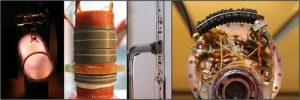
PhD work: Piegay (2002), Marion (2002), Baudin (2010)
Collaborative research projects: WideNMR (2016-2019), IMAGINE (2013-2016), DIPOL (2007-2011)
Introduction
Conventional descriptions of nuclear magnetic resonance (NMR) ignore collective effects for spin dynamics and the evolution of local magnetisation is described by a simple linear Bloch equation. This approach, usually justified in weakly polarised systems, turns out to be inappropriate for a liquid where nuclear polarisation is large. In such a liquid, dipolar magnetic interactions introduce a significant non-linear and non-local contribution to the Bloch equation that leads, for instance, to precession instabilities at large tip angles [1], [2], [3]. A variety of new phenomena related to the non-linear evolution of nuclear magnetisation in highly polarised liquid samples have been described in the past decade. In most cases they result from the intricate combination of (i) the non-linear coupling between the transverse nuclear magnetization and the detection coil (radiation damping, RD, a well-known NMR artefact) and (ii) the enhanced contribution of long-range magnetic interactions, not averaged out by the Brownian motion (distant dipolar fields, DDFs). Similar effects have been are in fact met in a wide range of other physical systems (such as Bose-Einstein condensates, superfluid 3He, two-dimensional atomic hydrogen gas or quantum entangled spin systems). The work carried out with laser-polarised noble gas atoms is expected to contribute to a better understanding of the spin dynamics in highly magnetised liquids. We perform NMR experiments at low field (2 mT) on bulk samples (0.5 cm³) of liquid helium mixtures that consist in hyperpolarised ³He atoms (with a high nuclear orientation obtained by MEOP in the gas phase at room temperature ) condensed in superfluid ⁴He. In these mixtures intrinsic longitudinal relaxation times are many hours long at low ³He concentrations [4]. Thanks to the hyperpolarisation process, dipolar fields reach a few µT (to be compared to the few nT obtained for proton at equilibrium in a standard 12T spectrometer) and bring a dominant contribution to the evolution of magnetisation in the liquid. This model system provides a great freedom for the control of key experimental parameters (diffusion coefficient, dipolar field strength), though the choice of operating conditions (temperature, concentration, and nuclear polarisation).
Investigation and control of NMR instabilities in hyperpolarised 3He solutions
In highly polarised ³He-⁴He mixtures, after a 90° pulse, free induction decay signals vanish in few tens of milliseconds (instead of typically one second at low magnetisation densities) [5]. This collapse is an evidence of the onset of dipolar instabilities, and results from the development of inhomogeneous magnetisation patterns that grow exponentially in time during transverse precession [6]. We have launched a study of dipolar instabilities using spin echo techniques, to determine the characteristic length scales of these magnetisation patterns. At high magnetisations, a simple 180°rf pulse fails to refocus transverse magnetisation. We therefore use a Magic Sandwich pulse sequence (a linked series of adequately phased 180° rf pulses, originally developed in solid-state NMR for strongly-coupled dipolar systems) to drive a time-reversed evolution of the magnetisation (at half the pace of the free evolution). Using a series of Magic Sandwich sequences, transverse magnetisation can be repeatedly refocussed and its lifetime can be increased by up to 3 orders of magnitude [7], [8], [9]. A quantitative analysis of the decay of the dynamically stabilised magnetisation has been carried out (E. Baudin, PhD work, 2010), both experimentally and numerically. For these studies, an active feedback scheme has been implemented on the NMR detection system to control its back-action on magnetisation [10] and to observe the intrinsic dipolar instabilities in the hyperpolarised mixtures.
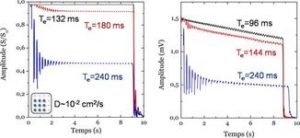
Computed (left) and observed (right) echo trains obtained with repeated magic sandwiches. Long NMR signal lifetimes are thus recovered.
The efficiency of time reversal has appeared to be very sensitive to homogeneity of the applied radiofrequency field. Work is in progress to perform experiments with improved rf coils and higher nuclear polarisations. The same feedback device will then be used to enhance (rather than decrease) radiation damping field, in order to investigate the behaviour of the magnetisation under the joint effect of DDF and RD. Radiation damping and dynamic instabilities actually play an increasing role due to sustained technological efforts to improve NMR signals, in particular in high-resolution NMR spectroscopy (a very powerful tool with applications in condensed matter physics, analytical chemistry, structural biology, or medicine). It is expected that our recent theoretical breakthroughs and the deeper understanding of rf-driven time evolution already obtained in a variety of situations (with/without DDF, RD, or spatial inhomogeneities of applied field) will lay the ground to new developments in this field. In particular, generic ways have been found to taylor robust composite pulses and to design more efficient NMR sequences. They will be experimentally validated.
Multiple spin echoes in highly magnetised liquids
Joint experiments have been performed with the team of H. Desvaux (LSDRM, CEA Saclay) to investigate other DDF-induced new phenomena, thanks to the DIPOL project (“Non-linear NMR in polarised liquids”, funded by the ANR). We have in particular studied the characteristics of multiple spin echoes (MSE) observed in highly magnetised liquids. This work has been carried out both with solutions of optically pumped ¹²⁹Xe in cyclohexane (at room temperature and 11.7 T, in Saclay) and our hyperpolarised He solutions (at low temperature and 3mT, at LKB) [11]. Two 90° pulses, separated by a phase-encoding period τ with an applied gradient, are followed by a train of echoes. These echoes are formed under the influence of the imprinted longitudinal magnetisation pattern if a strong initial magnetisation is present in the liquid.
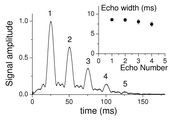 Example of multiple spin echoes recorded in hyperpolarised 3He -4He liquid mixtures. Slower diffusion leads to many more echoes for 129Xe dissolved in cyclohexane.
Example of multiple spin echoes recorded in hyperpolarised 3He -4He liquid mixtures. Slower diffusion leads to many more echoes for 129Xe dissolved in cyclohexane.
Several NMR experiments had been performed in the 1980s on thermally polarised solid ³He, liquid ³He and water for observing MSE due to dipolar fields. Our thorough investigation has used hyperpolarised liquids, thereby exploring ranges of average dipolar field that are one order of magnitude larger than that usually obtained with thermally polarized spin systems. We have thus reached regimes in which precession instabilities compete with the refocusing action of the gradient (Fig. below), which deserves further investigations. Moreover, we have benefited from the additional flexibility provided by the use of either ³He and ¹²⁹Xe solutions, that have very different diffusion properties.
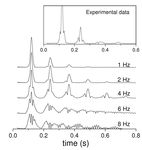 Example of data obtained by computer simulation of spin dynamics, for increasing distant dipolar field strengths. Inset: Experimental data obtained in a highly polarised liquid sample.
Example of data obtained by computer simulation of spin dynamics, for increasing distant dipolar field strengths. Inset: Experimental data obtained in a highly polarised liquid sample.
We have also performed extensive numerical lattice simulations including the effects of diffusion, magnetic field gradients, dipolar couplings, and rf field.
For realistic 3D simulations, with up to 2×10⁶ coupled magnetic moments, the computational load was heavy but manageable. The major outcome of our combined experimental and numerical studies is a detailed knowledge of the different contributions to the measured echoes amplitudes and, in particular, a reliable assessment of the finite size effects (usually overlooked or underestimated for analysis of echo attenuation). This quantitative knowledge provides the basis for a truly reference-free absolute measurement of magnetisation (a holy grail for NMR with out-of-equilibrium nuclear polarisation), just by comparison of relative amplitudes within a recorded echo train.
References:
[1] K.L. Sauer, F. Marion, P.-J. Nacher, and G. Tastevin, Phys. Rev. B. 63, 184427 (2001)
[2] P.-J. Nacher, G. Tastevin, B. Villard, N. Piegay, F. Marion, and K. L. Sauer, J. Low Temp. Phys. 121, 473 (2000)
[3] Y.Y. Lin, N. Lisitza, S.D. Ahn, and W.S. Warren, Science 290, 5489 (2000)
[4] N. Piegay, and G. Tastevin, J. Low Temp. Phys. 126, 157 (2002)
[5] P.-J. Nacher, N. Piegay, F. Marion, and G. Tastevin, J. Low Temp. Phys. 126, 145 (2002)
[6] J. Jeener, J. Chem. Phys. 116, 8439 (2002)
[7] M.E. Hayden, E. Baudin, G. Tastevin, and P.-J. Nacher, Phys. Rev. Lett. 99 (2007) 137602 (Open access archive HAL)
[8] E. Baudin, M.E. Hayden, G. Tastevin, and P.-J. Nacher, J. Low Temp. Phys. 150 (2008) 168 – 173 (Open access archive HAL)
[9] E. Baudin, M.E. Hayden, G. Tastevin, and P.-J. Nacher, Comptes Rendus Chimie 11 (2008) 560 – 567 (Open access archive HAL)
[10] E. Baudin, K. Safiullin, S.W. Morgan, and P.-J. Nacher, J. of Phys. : Conf. Series 294 (2011) 012009 (Open access)
[11] S.W. Morgan, E. Baudin, G. Huber, P. Berthault, G. Tastevin, P.-J. Nacher, M. Goldman, H. Desvaux, « Multiple dipolar echoes observed in dissoved laser-polarized noble gas solutions », Eur. Phys. J. D. (2013) 67 : 29 (Open access archive HAL)
Purchase of a wide bore NMR spectrometer/imager.
Objectives: Exploration of innovative concepts and applications in a very wide bore NMR instrument.
Scientific partners:
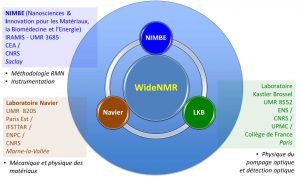
Coordinator: Patrick Berthault, LSDRM/NIMBE/IRAMIS, CEA Saclay
Project overview:
Research topics
- Hyperpolarisation and optical detection
- Applications of ultra-high nuclear magnetisations
- Developpements in biology and biomedical sciences
- Study of specific or constrainted materials
- Study of materials relevant for civil engineering
An NMR-based Investigation of MAGnetization-Induced Non-linear Effects
International collaborative project jointly supported by the ANR (Programme Blanc international, 2013-2016) and the FWF.

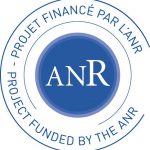

Main results
- Spin noise experiments: The first 2D spectrum detected by nuclear spin-noise has been reported. Comparison of various measurements has provided evidence for an unexpected behavior, which could not be explained by the existing approaches. In particular, it appeared that there were three different conditions for optimal tuning a high-resolution NMR probe. Findings have been described in an article, highlighted in SpectroscopyNow. Several developments (theory, simulations and experiments) have been performed for understanding this effect, taking into account other electronic elements which alter the spin dynamics. It has been shown to result from excitations due to fluctuations within the preamplifier impedance coupled through the transmission line (link to the publication). A protocol has been designed for ensuring proper choice of the length of the latter (link to the publication). Nuclear spin noise has also been used for monitoring of polarization buildup at 1.2K using dynamic nuclear polarization (link to the publication). In parallel, hardware developments were performed for ensuring better sensitivity combining microfluidics and microcoils (link to the publication). All these developments open promising perspectives in terms of spectroscopic measurements.
- MASER experiments: Several progresses have been performed in the understanding of the initiation of multiple maser emissions and of the chaotic-like features, in particular in terms of explaining why it can stop. Observations in hyperpolarised dissolved 129Xe, initially done in Saclay, have been extended to ³He apparatus in ENS thanks to new RF transmit coils for low frequency NMR. A complete analysis of the maser onset has been performed and results have been compared to theoretical predictions, which have also been derived. For in-depth understanding and 3D visualization of spin dynamics during the multiple maser emissions, large numerical lattice simulations have been performed. They already reveal the key role played by the distant dipolar fields (DDF), which leads to a fast crush of the transverse component of the nuclear magnetization. A first article on these simulations has been published. Thanks to the combination of experiments and numerical simulations, the origin of multiple maser emissions has been understood and the difference in behaviors observed in helium-3 and xenon- 129 could be positively related to the influence of Brownian diffusion.
- This work also led to progress in MR technology and new developments, associated to the implementation of new NMR microprobes and rf preamplifiers. There potential influence on spin dynamics has been considered. Further work will be carried out.
Non-linear NMR in polarised liquids – Influence of enhanced dipolar magnetic couplings
Collaborative project supported by the ANR (Programme Blanc, 2007-2011)
![]()
Control and use of non-linear effect in Nuclear Magnetic Resonance
Time-reversal techniques applied during the evolution of the magnetization are widely used in Nuclear Magnetic Resonance (NMR), and are in particular the basis for NMR imaging: MRI. For example, one controls the decay of the detected signal and its revival in the form of an echo that contains the information used to reconstruct an image. But such usual techniques are efficient only for systems having a regular temporal behaviour and are not suitable for strongly magnetized systems. The magnetic couplings between different parts of the sample are a source of nonlinearities in the response of the system to excitations. They induce very complex and sometimes chaotic dynamics. The magnetization, having become unstable, runs out of control and the detected signal abruptly disappears. Using a highly sensitive detection introduces an additional coupling and a nonlinearity that add to the complexity of the NMR response of the studied systems. It has become essential to understand and control the effects of these nonlinear couplings that more and more NMR users are facing. In addition, this non-linear response could be exploited to significantly increase the sensitivity of NMR in certain situations.
Hyperpolarized liquids: valuable strongly magnetized model systems for various NMR studies
Two hyperpolarized liquid can be obtained by dissolving isotopes of noble gas atoms, helium-3 and xenon-129, that are optically prepared beforehand (“optically pumped”) with nuclear polarizations up to 50%, and hence have magnetisations thousands of times higher than usual. Helium-3 is dissolved at low temperature in superfluid helium-4, while xenon is dissolved and studied at room temperature in an organic solvent. These two systems provide very high NMR signals and spectacular effects associated with strong magnetic couplings have been experimentally observed in recent years. In this project, they were studied in a complementary manner in magnetic fields of very different intensities (3 milli-Tesla for helium, nearly 12 Tesla for Xenon) and with adjustable couplings to the detection circuits. The experimental study of these model liquids was accompanied by numerical simulations of the temporal evolution of magnetization for discrete systems with thousands to millions of magnetically coupled elements.
Main results of the project
Two NMR detection techniques have been successfully developed and have led to an increased sensitivity of measurements: an efficient active feed-back scheme at low magnetic field, and a spin-noise detection scheme at high magnetic field. Both have found applications beyond this project. Different effects of the magnetic couplings on the precession of magnetization have been observed, characterized, and compared with numerical simulations in various situations: reversible instabilities and dynamic stabilization, irregular time patterns and disorder, numerous multiple echoes (see the illustration, below).
Scientific production and patents
The obtained experimental and numerical results have been the subject of two doctoral theses and of a dozen publications. They have been reported at national and international conferences, both general and specialized, and a patent was filed. (See list). The enhanced collaboration between the partner teams has fostered an exchange of tools and expertise that should shortly lead to new results and publications. An international cooperation and an industrial partnership have been undertaken on results obtained during the project.  Illustration NMR signals obtained in dissolved hyperpolarized Xe129 with strong magnetic coupling in the liquid. Unlike in an ordinary liquid, one can observe intermittent rather than regular spontaneous maser emission (a chaotic maser), or a large number of regularly decreasing echoes instead of a single echo (multiple echoes).
Illustration NMR signals obtained in dissolved hyperpolarized Xe129 with strong magnetic coupling in the liquid. Unlike in an ordinary liquid, one can observe intermittent rather than regular spontaneous maser emission (a chaotic maser), or a large number of regularly decreasing echoes instead of a single echo (multiple echoes).
Factual information
The DIPOL project is a fundamental research project coordinated by PJ Nacher (LKB) and involving two teams, at the Laboratoire Kastler Brossel [1] in Paris and at IRAMIS [2] in Saclay. The project began in November 2007 and lasted 46 months. It received support from the ANR (Blanc Programme). [1] UMR8552 CNRS, ENS and UPMC, http://www.lkb.science [2] The LSDRM belongs to the UMR 3299 of l’IRAMIS, http://iramis.cea.fr/sis2m/lsdrm/
LATEST COLLABORATORS
GRADUATE & UNDERGRADUATE STUDENTS
-
- Asmâa Agouzoul (Univ. de Reims Champagne-Ardennes, M2)
Yann Kergutuil (Univ. de Versailles Saint-Quentin-en-Yvelines, M2)
Lattice simulations in NMR: CPU versus GPU
March-Sept. 2016, M2 internships — Work supported by ICS@SU (Sorbonnes Universités)Projet de recherche collaboratif, interdisciplinaire et exploratoire, soutenu par l’Institut du calcul et de la simulation (ICS@SU, Sorbonne Universités)
- Partenaire associé : E. Baudin, Laboratoire Piere Aigrain.
- Modestin Sandjon (UPMC, M1)
Implementation of Arduino microcontrollers in low-field NMR experiments
May-June 2016, internship
- Ami Dramé and Janice Ronel (UPMC, L3)
NMR and MRI at low magnetic field.
January 2016, internship
- Mikhail Zakharov
Mikhail Zakharov (Kazan Federal Univ., Kazan, Russian Federation)
NMR precession instabilities in hyperpolarised He solutions
May – July 2015 — Work supported by the Lavrentiev prize 2013.
- Valentin Raban (ENS Lyon)
Nonlinear NMR in hyperpolarised liquid He mixtures
April – July 2015, M2 Internship
- Timur Salikhov (Kazan Federal Univ., Kazan, Russian Federation)
Nonlinear NMR and multiple maser emissions in hyperpolarised ³He fluids
June – July 2014, internship — Work supported by the Lavrentiev prize 2013.
- Dan Moinard (Univ. College London)
Maser studies in hyperpolarised ³He gas
June – July 2014, MSci Internship
- Jan Orkisz (ICFP)
Study of NMR maser instability in hyperpolarised liquid ³He
April – July 2014,M2 Internship
PhD STUDENTS & POST-DOCS
- Viacheslav KUZMIN (Kazan Federal Univ., Kazan, Russian Federation)
Post-doc, 2012 – 2015 — Work supported by ANR project “IMAGINE”, then by the Pierre-Gilles de Gennes Foundation
- Kajum Safiullin
Magnetic resonance of hyperpolarised helium-3 at low magnetic fields
PhD thesis, Sept. 2011 — Work supported by PHeLINet (Marie Curie RTN)
- Steven Morgan (Princeton University)
Post-doc, 2009 – 2011 — Work supported by ANR project “DIPOL”
- Emmanuel Baudin
PhD thesis, Sept. 2010
SENIOR VISITORS
- Pr Michael Hayden (Simon Fraser University, Vancouver, Canada)
January 2014.

